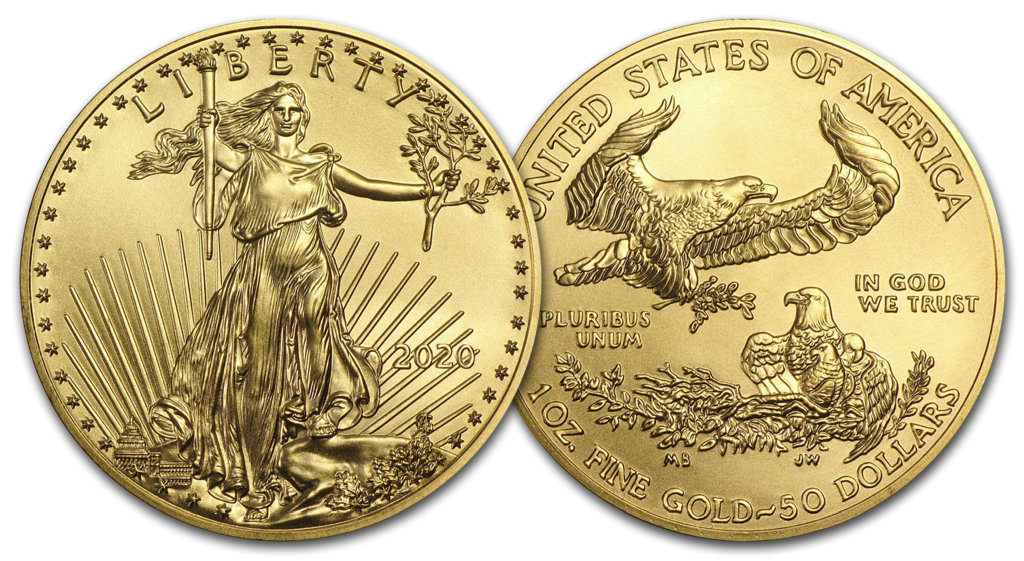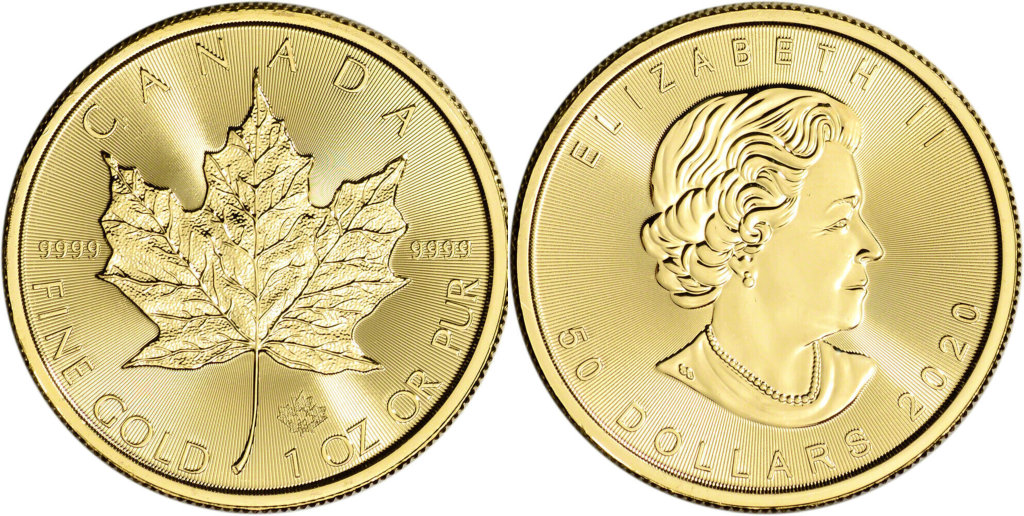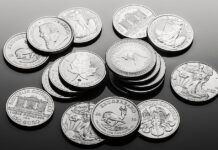Gold Coins
If you have already invested $20,000 in silver coins and you still have room in your budget, then it is time to consider gold.

Both Canada and the U.S. governments mint official 1-ounce gold coins. The U.S. makes the Gold Eagle coin from 22k (carat) gold and the American Buffalo from 24k gold, which is pure gold. Because it contains some copper and silver in addition to its one ounce of gold, the American eagle is larger and more durable than the Buffalo. The Canadian Gold Maple Leaf is also 1 ounce of pure (24k) gold. The Gold Eagle remains the most popular of them all and actually weighs 1.0909 troy ounces.
(If you plan to get into coins, you should read up on the difference between a Troy Ounce and how it differs from the traditional weights we use every day. Also, to protect yourself from counterfeit coins, you may wish to invest in a small scale and some other tools. Do some research to protect yourself.)
Right now, spot gold is $1,869 per ounce and a Gold Eagle sells for $1,969, giving it a $100 buyer’s premium. The Canadian Gold Maple Leaf is selling for $1,942, giving it a premium of $73.

Other Gold Coins
There are other countries that mint gold coins, including Australian Kangaroos. British Britannias, and South African Krugerrands. Krugerrands are internationally recognized and were once the best-known gold bullion coin in the world. We would rank it and the Britannia after the Canadian Maple leaf in popularity. Australian Kangaroos are less popular here in the U.S. but better than nothing.
I do not recommend gold coins from China or other countries, although you may find old collectible coins from Mexico or the UK. I do not recommend fractional gold coins (1/2 or 1/10 ounce, for example) because the premium is higher and if a gold coin is too big, then just pay with silver. Stick with the best-known gold coins to get the most out of your investment. I would also strongly discourage the purchase of tiny gold “bars” measured in grams. Stick with one-ounce coins.
Don’t buy old coins or old foreign coins. You can’t expect the average person to know how much gold is an an old English or Mexican coin. Stick with coins that plainly state their weight in gold.
Again, only buy gold coins after you have laid in a good supply of silver.
You don’t recommend silver rounds or Chinese coins. Are there any other things you do not recommend?
I generally do not recommend buying 5 or 10-ounce coins, which I believe are just a marketing gimmick. I do not recommend buying silver bars or small gold bars. Stick to one ounce coins. With the exception of winning the Powerball jackpot, I cannot imagine a scenario in which I would buy a 100 ounce or another large gold bar.
I don’t recommend 100 ounce silver bars either. Buy a gold coin instead. It is lighter, far more transportable, easier to hid and easier to sell.
UPDATE January 2023: There are many silver bars and gold bars on the market that can be useful stores of wealth. There has been a wave of fake gold bars being sold to individuals and too pawn shops. Don’t make a $2,000 mistake. Buy from legitimate dealers and ask them to test the gold right there in front of you.
I do not recommend collectable coins for preppers. While a gold coin minted in 1920 will cost more than one minted in 2020 (due to scarcity), no one will care after the world as we know it comes to an end. Once ounce of gold will be one ounce of gold, regardless if the coin is rare or not. Along similar lines, I would not pay more for proof sets or slabbed coins that are marked as MS-69 or MS-70 (meaning mint state). Coins are graded to determine their scarcity and value. We preppers don’t care. We want them for their gold content, not how shiny or new they look.
Can I buy PMs with my IRA funds?
Yes, it can be done, but the real question is should you.
OK, should I put PMs in my IRA?
I am not a financial advisor, but in my opinion, no you should not put precious metals in your IRA. To put physical gold or silver in an IRA, you have to create a self-direct IRA, then you need a gold broker to buy the gold for you and a gold custodian to hold it for you. Each of these steps costs money, and as we have already seen, there is a buyer’s premium, which is much higher than the fee you usually pay to buy a mutual fund or to trade a stock.
But the biggest reason I discourage it is that you don’t get to take possession of the gold. The custodian – usually a trust company, brokerage firm or bank – holds the gold on your behalf. Well, in a post-TEOTWAWKI situation, you won’t be able to access those PMs because they are in a vault somewhere, probably in some distant city.
When you own PMs for use during or after a massive societal collapse, you want them where you can control them and access them. That means owning physical gold and silver, not “paper” gold and silver.
If you want to invest in PMs in your IRA, you are better off buying and exchange traded fund (ETF) that holds silver or gold, a mutual fund for PMs, stocks of gold and silver miners, and other investment vehicles that can be held in a ROTH or traditional IRA.
How should I store and protect my physical gold and silver?
I recommend you store them is a safe location. Your gun safe is a good start, but if you have tens of thousands in PMs, upgrade to a vault that will be tougher to break into than a gun safe you bought for less than $1,000. I also recommend that you do not store them all in one place, on the off chance that you are robbed. Find some hiding places, just make sure you keep notes so you (or your heirs) can find them again. Losing $20,000 in gold would really suck. Oh, and avoid common hiding spots like the toilet tank and the freezer. Secret them away somewhere like in the bottom of an old tool box in your barn.
I do not recommend storing PMs in a safe deposit box unless you put only a small portion of them in there. In a disaster, your bank is probably going to be closed and you won’t be able to access your box, or your PMs.
Who sets the price of gold and silver?
Gold and silver futures are traded on commodity exchanges around the world. The price is determined by what people will sell for or buy for, and this can fluctuate by the minute. The market sets the price, but can be influenced by how many people want to buy gold, how many want to sell gold, and large orders from buyers. Political and economic news can also affect prices as gold is seen as a hedge against inflation. When markets fall, investors often run to the perceived “safe haven” of gold, driving up its price.
Silver is also traded similarly but it has more industrial uses, so more silver is consumed and vanishes from the market.
For both metals, the spot price is based on what is the forward month’s contract with the most volume.
Summary
To recap the above, yes, Pete believes precious metals can play an important role for preppers, but:
- Only buy silver and gold when you are far enough along your prepper journey that you have all your other needs covered.
- Start by buying junk silver and then expand into Silver American Eagles or Silver Canadian Maple Leafs
- Buy gold only after you have plenty of silver.
- Do not buy rounds r bars. Stick with coins from well-known government mints.
- Buy only Gold Eagles, Gold Maple Leafs, Britannias, and Krugerrands, not gold coins from China.
- Buy only one ounce coins, not fractionals.
- Be careful of counterfeit coins and bars. Learn how to test your PMs with a magnet, a scale and the ping test.
- Keep physical coins in a safe place where you can access them in an emergency.
- Buy ETFs and stocks or mutual funds for your retirement and other investment accounts.






